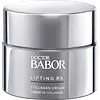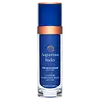What's inside
What's inside
 Key Ingredients
Key Ingredients

 Benefits
Benefits

 Concerns
Concerns

 Ingredients Side-by-side
Ingredients Side-by-side

Water
Skin ConditioningGlycerin
HumectantMacadamia Integrifolia Seed Oil
Skin ConditioningSqualane
EmollientDicaprylyl Carbonate
EmollientPersea Gratissima Oil
Skin ConditioningCetearyl Alcohol
EmollientSesamum Indicum Seed Oil
EmollientHydrogenated Vegetable Glycerides
EmollientButylene Glycol
HumectantPotassium Cetyl Phosphate
EmulsifyingTocopheryl Acetate
AntioxidantPhenoxyethanol
PreservativeHydrogenated Palm Glycerides
EmollientPanthenol
Skin ConditioningDimethicone
EmollientParfum
MaskingSodium Hyaluronate
HumectantXanthan Gum
EmulsifyingEthylhexylglycerin
Skin ConditioningPotassium Sorbate
PreservativeDisodium EDTA
Alcohol
AntimicrobialLinalool
PerfumingHexyl Cinnamal
PerfumingCitric Acid
BufferingSoluble Collagen
HumectantCaprylic/Capric Triglyceride
MaskingLimonene
PerfumingGeraniol
PerfumingSodium Benzoate
MaskingPantolactone
HumectantAscorbyl Palmitate
AntioxidantPalmitoyl Tripeptide-5
Skin ConditioningBenzyl Alcohol
PerfumingBenzyl Benzoate
AntimicrobialAscorbic Acid
AntioxidantTrifluoroacetyl Tripeptide-2
Skin ConditioningDextran
Water, Glycerin, Macadamia Integrifolia Seed Oil, Squalane, Dicaprylyl Carbonate, Persea Gratissima Oil, Cetearyl Alcohol, Sesamum Indicum Seed Oil, Hydrogenated Vegetable Glycerides, Butylene Glycol, Potassium Cetyl Phosphate, Tocopheryl Acetate, Phenoxyethanol, Hydrogenated Palm Glycerides, Panthenol, Dimethicone, Parfum, Sodium Hyaluronate, Xanthan Gum, Ethylhexylglycerin, Potassium Sorbate, Disodium EDTA, Alcohol, Linalool, Hexyl Cinnamal, Citric Acid, Soluble Collagen, Caprylic/Capric Triglyceride, Limonene, Geraniol, Sodium Benzoate, Pantolactone, Ascorbyl Palmitate, Palmitoyl Tripeptide-5, Benzyl Alcohol, Benzyl Benzoate, Ascorbic Acid, Trifluoroacetyl Tripeptide-2, Dextran
Water
Skin ConditioningCoco-Caprylate/Caprate
EmollientHelianthus Annuus Seed Oil
EmollientSqualane
EmollientGlycerin
HumectantArgania Spinosa Kernel Oil
EmollientEthyl Oleate
EmollientPersea Gratissima Oil
Skin ConditioningPolyglyceryl-4 Oleate
EmulsifyingMagnesium Sulfate
Oenothera Biennis Oil
EmollientPanthenol
Skin ConditioningPolyglyceryl-6 Oleate
EmulsifyingZinc PCA
HumectantPolyhydroxystearic Acid
EmulsifyingButylene Glycol
HumectantButyrospermum Parkii Butter
Skin ConditioningPotassium Sorbate
PreservativeSodium Benzoate
MaskingTocopherol
AntioxidantSodium Hyaluronate
HumectantHydrolyzed Rice Protein
Skin ConditioningMaltodextrin
AbsorbentCitric Acid
BufferingCamellia Sinensis Leaf Extract
AntimicrobialHydrogenated Lecithin
EmulsifyingTocopheryl Acetate
AntioxidantXanthan Gum
EmulsifyingAlanyl Glutamine
HumectantArginine
MaskingOligopeptide-177
Phenylalanine
MaskingSisymbrium Irio Seed Oil
MaskingSodium Chloride
MaskingDextran
Palmitoyl Tripeptide-8
Skin ConditioningWater, Coco-Caprylate/Caprate, Helianthus Annuus Seed Oil, Squalane, Glycerin, Argania Spinosa Kernel Oil, Ethyl Oleate, Persea Gratissima Oil, Polyglyceryl-4 Oleate, Magnesium Sulfate, Oenothera Biennis Oil, Panthenol, Polyglyceryl-6 Oleate, Zinc PCA, Polyhydroxystearic Acid, Butylene Glycol, Butyrospermum Parkii Butter, Potassium Sorbate, Sodium Benzoate, Tocopherol, Sodium Hyaluronate, Hydrolyzed Rice Protein, Maltodextrin, Citric Acid, Camellia Sinensis Leaf Extract, Hydrogenated Lecithin, Tocopheryl Acetate, Xanthan Gum, Alanyl Glutamine, Arginine, Oligopeptide-177, Phenylalanine, Sisymbrium Irio Seed Oil, Sodium Chloride, Dextran, Palmitoyl Tripeptide-8
 Reviews
Reviews

Ingredients Explained
These ingredients are found in both products.
Ingredients higher up in an ingredient list are typically present in a larger amount.
Butylene Glycol (or BG) is used within cosmetic products for a few different reasons:
Overall, Butylene Glycol is a safe and well-rounded ingredient that works well with other ingredients.
Though this ingredient works well with most skin types, some people with sensitive skin may experience a reaction such as allergic rashes, closed comedones, or itchiness.
Learn more about Butylene GlycolCitric Acid is an alpha hydroxy acid (AHA) naturally found in citrus fruits like oranges, lemons, and limes.
Like other AHAs, citric acid can exfoliate skin by breaking down the bonds that hold dead skin cells together. This helps reveal smoother and brighter skin underneath.
However, this exfoliating effect only happens at high concentrations (20%) which can be hard to find in cosmetic products.
Due to this, citric acid is usually included in small amounts as a pH adjuster. This helps keep products slightly more acidic and compatible with skin's natural pH.
In skincare formulas, citric acid can:
While it can provide some skin benefits, research shows lactic acid and glycolic acid are generally more effective and less irritating exfoliants.
Most citric acid used in skincare today is made by fermenting sugars (usually from molasses). This synthetic version is identical to the natural citrus form but easier to stabilize and use in formulations.
Read more about some other popular AHA's here:
Learn more about Citric AcidDextran is a sugar (polysaccharide) with skin hydrating properties.
Fun fact: Louis Pasteur first discovered this ingredient as a microbial product in wine.
Glycerin is already naturally found in your skin. It helps moisturize and protect your skin.
A study from 2016 found glycerin to be more effective as a humectant than AHAs and hyaluronic acid.
As a humectant, it helps the skin stay hydrated by pulling moisture to your skin. The low molecular weight of glycerin allows it to pull moisture into the deeper layers of your skin.
Hydrated skin improves your skin barrier; Your skin barrier helps protect against irritants and bacteria.
Glycerin has also been found to have antimicrobial and antiviral properties. Due to these properties, glycerin is often used in wound and burn treatments.
In cosmetics, glycerin is usually derived from plants such as soybean or palm. However, it can also be sourced from animals, such as tallow or animal fat.
This ingredient is organic, colorless, odorless, and non-toxic.
Glycerin is the name for this ingredient in American English. British English uses Glycerol/Glycerine.
Learn more about GlycerinPanthenol is a common ingredient that helps hydrate and soothe the skin. It is found naturally in our skin and hair.
There are two forms of panthenol: D and L.
D-panthenol is also known as dexpanthenol. Most cosmetics use dexpanthenol or a mixture of D and L-panthenol.
Panthenol is famous due to its ability to go deeper into the skin's layers. Using this ingredient has numerous pros (and no cons):
Like hyaluronic acid, panthenol is a humectant. Humectants are able to bind and hold large amounts of water to keep skin hydrated.
This ingredient works well for wound healing. It works by increasing tissue in the wound and helps close open wounds.
Once oxidized, panthenol converts to pantothenic acid. Panthothenic acid is found in all living cells.
This ingredient is also referred to as pro-vitamin B5.
Learn more about PanthenolPersea Gratissima Oil is also known as avocado oil.
Avocado Oil has antioxidant properties. It is mostly made up of the glycerides of fatty acids. About 67% of these fatty acids is made up of oleic acid. Palmitic acid and linoleic acid are also present.
These fatty acids help hydrate and soften the skin. It may increase collagen content in the skin. Collagen helps keep your skin plump and firm. This ingredient helps reduce inflammation and has not shown to clog pores.
This ingredient may not be fungal-acne safe due to its high fatty acid content.
Avocados also have B vitamins, vitamin K, vitamin C, vitamin E, and potassium.
Learn more about Persea Gratissima OilPotassium Sorbate is a preservative used to prevent yeast and mold in products. It is commonly found in both cosmetic and food products.
This ingredient comes from potassium salt derived from sorbic acid. Sorbic acid is a natural antibiotic and effective against fungus.
Both potassium sorbate and sorbic acid can be found in baked goods, cheeses, dried meats, dried fruit, ice cream, pickles, wine, yogurt, and more.
You'll often find this ingredient used with other preservatives.
Learn more about Potassium SorbateSodium Benzoate is a preservative. It's used in both cosmetic and food products to inhibit the growth of mold and bacteria. It is typically produced synthetically.
Both the US FDA and EU Health Committee have approved the use of sodium benzoate. In the US, levels of 0.1% (of the total product) are allowed.
Sodium benzoate works as a preservative by inhibiting the growth of bacteria inside of cells. It prevents the cell from fermenting a type of sugar using an enzyme called phosphofructokinase.
It is the salt of benzoic acid. Foods containing sodium benzoate include soda, salad dressings, condiments, fruit juices, wines, and snack foods.
Studies for using ascorbic acid and sodium benzoate in cosmetics are lacking, especially in skincare routines with multiple steps.
We always recommend speaking with a professional, such as a dermatologist, if you have any concerns.
Learn more about Sodium BenzoateSodium Hyaluronate is hyaluronic acid's salt form. It is commonly derived from the sodium salt of hyaluronic acid.
Like hyaluronic acid, it is great at holding water and acts as a humectant. This makes it a great skin hydrating ingredient.
Sodium Hyaluronate is naturally occurring in our bodies and is mostly found in eye fluid and joints.
These are some other common types of Hyaluronic Acid:
Learn more about Sodium HyaluronateSqualane is an emollient that helps the skin hold onto moisture. It's an oily liquid that occurs naturally in certain types of fish and plant oils.
Because squalane boosts hydration in the skin, it also comes with plenty of benefits: it is an antioxidant and can help fight free radicals and skin damage. Squalane is also found to have a detoxifying effect when applied.
Squalane comes from squalene, which occurs naturally within the sebum of our skin. It is one of the oils our skin produces to keep itself hydrated. Squalane is the hydrogenated version of squalene and has a longer shelf life.
Research shows that squalane is non-irritating (even at 100% concentration).
In general, it's a fantastic ingredient. It does a great job at hydrating the skin, and it's suitable for those with sensitive skin.
The source of squalane may impact malassezia / fungal acne. This is because olive oil derived squalane can contain impurities such as fatty acids and plant waxes. Sugarcane derived squalane is recommended for anyone with malassezia concerns.
Is squalane vegan?
This depends on the source. Squalane can be derived from both plants and animals. Most squalane used in skincare comes from plants.
Please note: the source of squalane is only known if disclosed by the brand. We recommend reaching out to the brand if you have any questions about their squalane.
Read more about squalene with an "e".
Is squalane an oil?
Squalane is often called an oil, but it’s technically not; it’s a hydrocarbon, meaning it’s only made of carbon and hydrogen, unlike true oils which are triglycerides made of fatty acids and glycerol.
The term “oil-free” isn’t regulated, so companies can define it however they want. Some exclude all oils, while others just avoid mineral oil or comedogenic oils.
While some people avoid oils thinking they cause breakouts, the right kind of oil (or oil-like ingredient like squalane) can actually help balance and hydrate your skin. It’s worth testing out simple oils or squalane to see what works best for your skin.
Learn more about SqualaneTocopheryl Acetate is AKA Vitamin E. It is an antioxidant and protects your skin from free radicals. Free radicals damage the skin by breaking down collagen.
One study found using Tocopheryl Acetate with Vitamin C decreased the number of sunburned cells.
Tocopheryl Acetate is commonly found in both skincare and dietary supplements.
Learn more about Tocopheryl AcetateWater. It's the most common cosmetic ingredient of all. You'll usually see it at the top of ingredient lists, meaning that it makes up the largest part of the product.
So why is it so popular? Water most often acts as a solvent - this means that it helps dissolve other ingredients into the formulation.
You'll also recognize water as that liquid we all need to stay alive. If you see this, drink a glass of water. Stay hydrated!
Learn more about WaterXanthan gum is used as a stabilizer and thickener within cosmetic products. It helps give products a sticky, thick feeling - preventing them from being too runny.
On the technical side of things, xanthan gum is a polysaccharide - a combination consisting of multiple sugar molecules bonded together.
Xanthan gum is a pretty common and great ingredient. It is a natural, non-toxic, non-irritating ingredient that is also commonly used in food products.
Learn more about Xanthan Gum